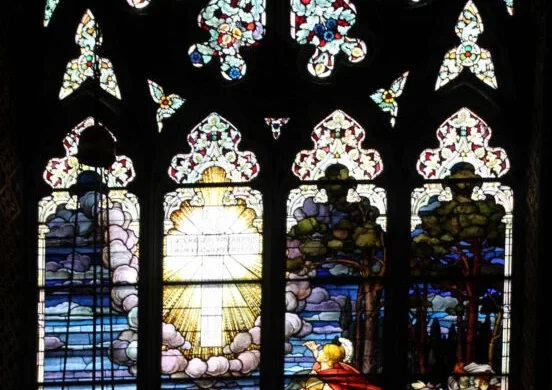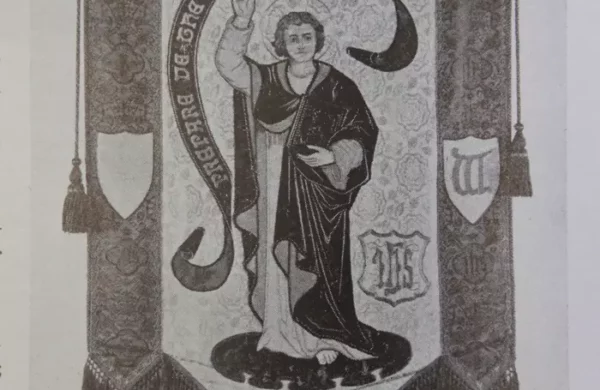Saint Jerome, a revered church father born around 342 A.D. in northern Italy. Raised in a Christian family, he renounced worldly pursuits, journeyed to Rome, and was baptized by Pope Liberius. Jerome immersed himself in studying Biblical languages and Scriptures. After traveling, he settled in Bethlehem, devoting his life to Biblical scholarship and translation. Saint Jerome passed away on September 30, 420 A.D.
Like this:
Like Loading...

Before the Renaissance, the corporal was often as big as an altar cloth. Since then, it has had smaller dimensions, depending on the size of the altar. It remains essentially a corporal as long as it holds the chalice, the paten, the host, and the ciborium cover. As the corporal is a simple cloth that has the honor of holding the Eucharist, it needs little decoration to complete its job
Like this:
Like Loading...

In the thirteenth century, the papal tiara evolved with a cone shape, growing taller. The peak had an egg shape, and the bottom was adorned with a headband. Styles included vertical or crisscross bands of gold, while the cap remained white linen or cloth of gold. Gems and pearls adorned the tiara. St. Gregory is depicted wearing a thirteenth-century tiara with a vertical band, while Pope Clement IV’s tiara had crisscross bands. Clement, presenting the crown of the Two Sicilies, wore a gold tiara adorned with jewels and fleurons.
Like this:
Like Loading...

Ecclesiastical Sewing shares a valuable tip for precise pattern placement when cutting stoles from the stunning red Lichfield Liturgical Fabric. By folding the paper pattern in half along the stole’s length and aligning the fold with the center of the design motif, the risk of misalignment is minimized. This practical method ensures a beautifully centered stole with ease.
Like this:
Like Loading...

Fine linen fabrics are the first step to review when considering making new altar linens for your church. At Ecclesiastical Sewing, we offer an assortment of fine linens, knowing that one linen does not suit all needs.
Like this:
Like Loading...

St. Hubert (656–727 A.D.), Bishop of Liege and patron of hunters, hailed from the Dukedom of Aquitaine. Once a grand master, he turned to hunting and soldiering. On a Good Friday hunt, a stag, bearing a cross, urged him to repent. His wife’s death led him to forsake worldly possessions, becoming a priest in Stavelot, Belgium. Following Lambert’s assassination, Hubert, sent by the Pope, became Bishop. He lived a virtuous life and died as a confessor, confessing the faith, though not a martyr.
Like this:
Like Loading...

Lichfield Liturgical Fabric features two main motifs: a Fluer Cross and a Tudor Rose. Both motifs are roughly the same size, also a trailing vine that surrounds the rose. The plan for Lichfield is to make several pastoral stoles and a chasuble – Pattern matching with liturgical vestment.
Like this:
Like Loading...

September 14th is noted as Holy Cross Day, which is celebrated in both Eastern and Western Churches around the world. The Church of England marks this festival day with the use of the color Red. Holy Cross Day was introduced into the Lutheran Church-Missouri Synod in 1982, yet this festival may be unfamiliar to many Lutherans today. The history of this festival dates back to the time of Constantine and his mother, St. Helena.
Like this:
Like Loading...

. September 13th is the feast day for St. John Chrysostom–born circa 349 A.D., although many dates between 344 A.D. and 354 A.D. have been argued for by various scholars. This man is one of the pillars of the faith, a church father. His early education influenced his ability to lead the Church and give her many gifts in the form of sermons and liturgy.
Like this:
Like Loading...

Each fabric is beautiful in its own special way, be it color, pattern, texture, or drape. Each has characteristics that lend it to be the perfect liturgical fabric for special use. The fiber contents are as varied as the patterns, fabrics, and weaves. The price points range from moderate prices for churches on a budget, to exclusive silks and cloth of gold fabrics intended for unique and special sacred vestments. There are solids, piece-dyed, and yarn-dyed fabrics, brocades, metallics, plain weaves, and crisp linens that range from the brightest whites to the deepest and richest violet, and the warmest and richest golds and vibrant reds.
Like this:
Like Loading...

The mitre is a white linen cap that is stiffened with parchment–in the modern era, thin plastic or cardboard can be used–and placed upon a stiff linen band. This linen band is then encircled with gold and there can be at the apex a cone of gold. In this century, not only did this special cap receive a name, but the custom of the pope bestowing the mitre on his favorite bishops came into practice. In the twelfth century, the rounded top of the cap began to dip in the middle, due to the binding of a band of gold that ran from front to back.
Like this:
Like Loading...

The amice is the first garment to be put on by a priest. It is worn on the head, while he offers up prayers and intercessions, and then he continues to dress. After the alb is put on, the amice is pushed off his head and worn around his neck as a collar. The long cords of the amice are then tied around the alb under the arms, crossed around the back, and brought back to the front to be tied. All this being said, there are instances when the amice is kept upon the head for practical reasons: such as warmth during a processional or in a particularly drafty church.
Like this:
Like Loading...

The Cleveland Museum owns four pieces of liturgical vessels from circa 500-700 A.D. This set was discovered in Northern Syria, where early Christians would have buried their precious goods from the invading Persians or Arabs. There are three chalices and one paten in this set. These are all silver; and the chalices are decorated with Saint Peter, Saint Paul, Christ, and the Blessed Virgin. The collection was given to a priest named Zeno by Kyriakos son of Domnos.
Like this:
Like Loading...

Beautiful ecclesiastical vestments, church art, and church architecture are not reserved for world-renowned cathedrals. Beauty is often found in places where worship still takes place on a healthy and active basis. This is because precious treasures can be found still in their original use instead of cased up–as if entombed–for tourists to view for thirty seconds before moving past.
Like this:
Like Loading...














You must be logged in to post a comment.